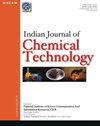Sesame lignans as promising anti-inflammatory agent: Exploring novel therapeutic avenues with in silico and computational approach
IF 0.5
4区 工程技术
Q4 CHEMISTRY, APPLIED
引用次数: 1
Abstract
Innumerable health-beneficial properties of sesame lignans like sesamol, sesamolin, sesamin and sesaminol make them lucrative agents in the pharmaceutical industry. To specify the mode of action of these phytochemicals, detailed computational physicochemical properties evaluation, and toxicity assessment (using free web servers and databases), as well as binding interactions with physiological inflammatory effectors (such as COX-2, TNF-α , IL-1 β , IL-6) by means of rigid ligand-receptor docking (using software), have been thoroughly investigated. Interestingly, sesame lignans are conformed to have drug-likeness, indicating their efficacy and suitability like established therapeutics. These bioactive lignans possess drug-like attributes and effectively act as ligands in the present in-silico study. The basic pharmacokinetic profile of these compounds has suggested non-polar solvents or delivery systems for them to enhance their bioavailability in physiological systems. However, all the sesame lignans are toxic to the liver cells with a50 % lethal dose in the range of 500-1500 mg/kg. Toxicity study indicated minimum toxicity of lignans to normal cellular milieu, but noticeable cytotoxic effects against several cancerous cell lines suggesting their anti-carcinogenic properties. Finally, the findings of the molecular docking study have depicted a high affinity of these ligands for target proteins, even better than traditional anti-inflammatory drugs-Indomethacin and Ibuprofen. The molecular interactions have represented sesaminol as the most effective and Sesamol as the least potent ligand for target receptor whereas COX-2 seems to be the most vulnerable target. The docking scores varied widely (-4.7 to -11.0 kcal/mol). The present in-silico approach is expected to provide valuable resources for optimizing bioactive molecules as future-generation therapeutics before pre-clinical and clinical studies.芝麻木脂素作为有前途的抗炎剂:用计算机和计算方法探索新的治疗途径
芝麻木脂素的无数有益健康的特性,如芝麻酚、芝麻素、芝麻素和芝麻素,使它们成为制药行业利润丰厚的代理商。为了明确这些植物化学物质的作用模式,详细的计算理化性质评估和毒性评估(使用免费的web服务器和数据库),以及通过刚性配体-受体对接(使用软件)与生理炎症效应物(如COX-2, TNF-α, IL-1 β, IL-6)的结合相互作用进行了深入研究。有趣的是,芝麻木脂素与药物相似,表明它们的疗效和适用性与现有的治疗方法相似。这些具有生物活性的木脂素具有类似药物的属性,在目前的计算机研究中有效地充当配体。这些化合物的基本药代动力学特征表明,非极性溶剂或递送系统可以提高它们在生理系统中的生物利用度。然而,所有的芝麻木脂素对肝细胞都有毒性,在500- 1500mg /kg的范围内有50%的致死剂量。毒性研究表明木脂素对正常细胞环境的毒性最小,但对几种癌细胞有明显的细胞毒性作用,表明其具有抗癌作用。最后,分子对接研究的结果表明,这些配体对靶蛋白具有很高的亲和力,甚至比传统的消炎药——吲哚美辛和布洛芬更好。分子相互作用表明芝麻醇是最有效的靶受体配体,而芝麻醇是最弱的靶受体配体,而COX-2似乎是最脆弱的靶标。对接分数变化很大(-4.7到-11.0千卡/摩尔)。目前的计算机方法有望为优化生物活性分子提供宝贵的资源,作为临床前和临床研究之前的下一代治疗方法。
本文章由计算机程序翻译,如有差异,请以英文原文为准。
求助全文
约1分钟内获得全文
求助全文
来源期刊

Indian Journal of Chemical Technology
工程技术-工程:化工
CiteScore
0.90
自引率
20.00%
发文量
17
审稿时长
6-12 weeks
期刊介绍:
Indian Journal of Chemical Technology has established itself as the leading journal in the exciting field of chemical engineering and technology. It is intended for rapid communication of knowledge and experience to engineers and scientists working in the area of research development or practical application of chemical technology. This bimonthly journal includes novel and original research findings as well as reviews in the areas related to – Chemical Engineering, Catalysis, Leather Processing, Polymerization, Membrane Separation, Pharmaceuticals and Drugs, Agrochemicals, Reaction Engineering, Biochemical Engineering, Petroleum Technology, Corrosion & Metallurgy and Applied Chemistry.
 求助内容:
求助内容: 应助结果提醒方式:
应助结果提醒方式:


